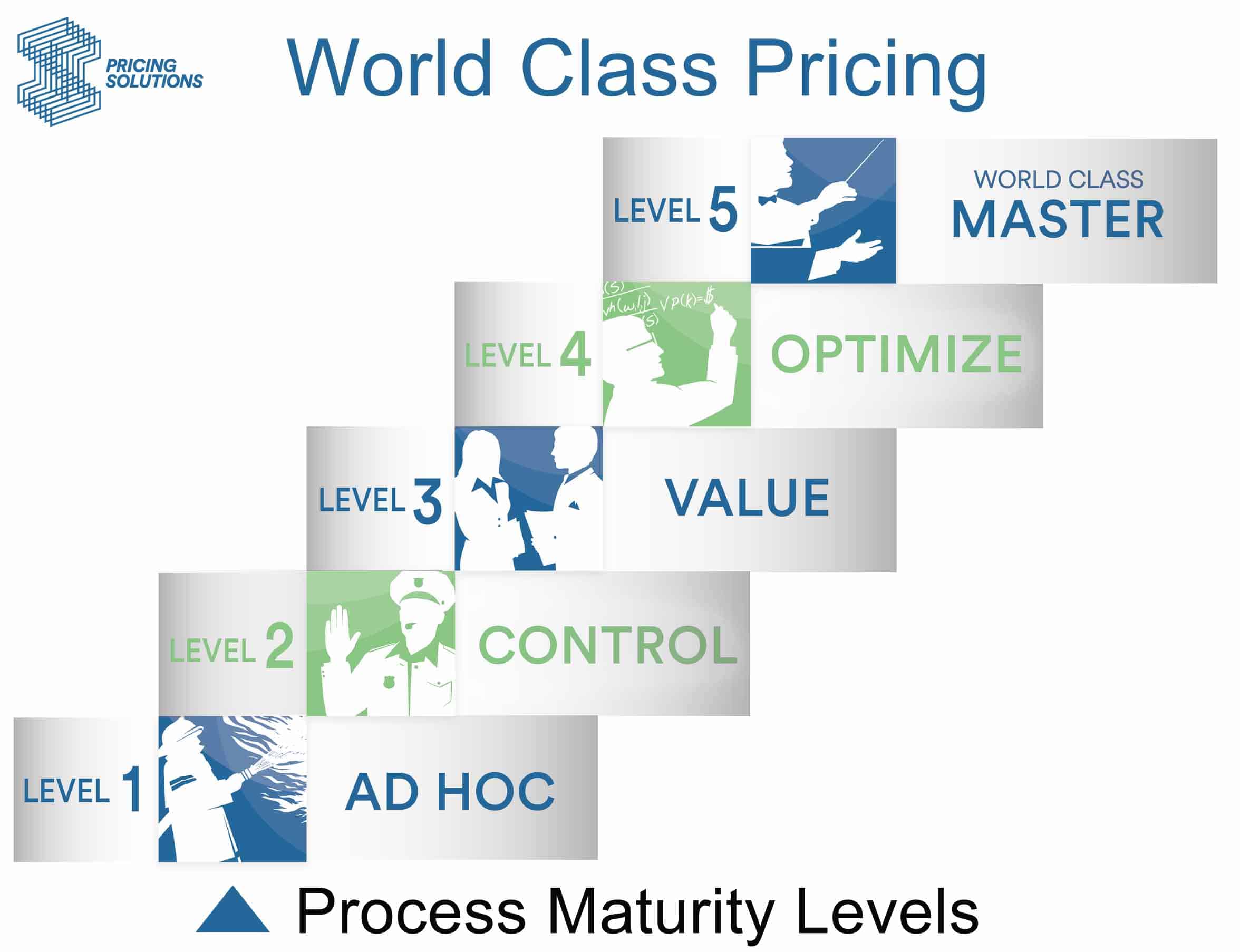Every business has a pricing process. Find out where your organization falls in the 5-Levels of World Class Pricing.
Not long ago I thought it was time to “get personal about pricing,” and wrote World Class Pricing: The Journey. More than 20 years of experience and 700 projects went into developing a roadmap to pricing improvements that now all our clients use. Although every business has a pricing process, it can be difficult to determine where your organization falls in the 5-Levels:
Level 1: The Firefighter
 Firefighters constantly put themselves in harm’s way, often for little reward. In our experience Level 1 pricing managers also fit this description. At Level 1 the pricing process is a chaotic one. Pricing is extremely ad hoc and reactive. Sales teams are at the helm of pricing and are under extreme pressure to lower prices or face lost deals and unhappy customers. This fear typically leads to deep discounting, which is unsustainable. Companies at Level 1 are looking to break free of Firefighting and replace reactive decision-making – and the fear that dominates it– with proactive tools and processes.
Firefighters constantly put themselves in harm’s way, often for little reward. In our experience Level 1 pricing managers also fit this description. At Level 1 the pricing process is a chaotic one. Pricing is extremely ad hoc and reactive. Sales teams are at the helm of pricing and are under extreme pressure to lower prices or face lost deals and unhappy customers. This fear typically leads to deep discounting, which is unsustainable. Companies at Level 1 are looking to break free of Firefighting and replace reactive decision-making – and the fear that dominates it– with proactive tools and processes.
Level 2: The Policeman
 Level 2 is all about control, enforcement and accountability. While we refer to it as the Policeman, we’re not talking ‘Dirty Harry’ policing. If pricing managers have the same take-no-prisoners attitude Clint Eastwood’ s ‘Dirty Harry’ character did, sales willquickly rebel and find ways to work around the pricing department. Even so, at Level 2, sales may see the rigidity of new pricing processes as inflexible and out of touch with market and customer needs. Consequently, companies here look for a strong pricing manager that can link the pricing process to other core company processes, including its tie to profitability. It’s also important to make improvements in sales compensation. Rewarding sales for improving profits and making the transition from price-cutting to selling on value can go a long way in helping to make a smooth transition to Level 2.
Level 2 is all about control, enforcement and accountability. While we refer to it as the Policeman, we’re not talking ‘Dirty Harry’ policing. If pricing managers have the same take-no-prisoners attitude Clint Eastwood’ s ‘Dirty Harry’ character did, sales willquickly rebel and find ways to work around the pricing department. Even so, at Level 2, sales may see the rigidity of new pricing processes as inflexible and out of touch with market and customer needs. Consequently, companies here look for a strong pricing manager that can link the pricing process to other core company processes, including its tie to profitability. It’s also important to make improvements in sales compensation. Rewarding sales for improving profits and making the transition from price-cutting to selling on value can go a long way in helping to make a smooth transition to Level 2.
Level 3: The Partner
 As the title suggests, at Level 3 pricing, sales, marketing, operations and finance have formed a partnership and work to achieve consensus in pricing. Each department is counted on to provide insights into the company’s value proposition and communicate credible customer information. The task no longer falls to just sales. These collective discussions around value and price result in more profitable pricing strategies. However, the climb from Policeman to Partner is a steep one. It’s difficult to transition from an ‘inside-out’ to an ‘outside-in,’ value-based perspective. We discuss this transition in great detail in World Class Pricing: The Journey because typically it’s an 18- 36 month process.
As the title suggests, at Level 3 pricing, sales, marketing, operations and finance have formed a partnership and work to achieve consensus in pricing. Each department is counted on to provide insights into the company’s value proposition and communicate credible customer information. The task no longer falls to just sales. These collective discussions around value and price result in more profitable pricing strategies. However, the climb from Policeman to Partner is a steep one. It’s difficult to transition from an ‘inside-out’ to an ‘outside-in,’ value-based perspective. We discuss this transition in great detail in World Class Pricing: The Journey because typically it’s an 18- 36 month process.
Level 4: The Scientist
 Sophisticated optimization research is at the heart of The Scientist. Before jumping into optimization though, companies first deepen their understanding of elasticity. Elasticity helps answer questions like, should the price of existing products be increased or decreased? What is the optimal price gap between different SKUs or a new competitive entrant? How can incentives be optimized? Or what is the optimal price structure? Although the calculation is simple, actually determining elasticity is difficult – the demand curve is not always a smooth, steadily declining line. However, Level 4 pricing mangers don’t need to become statisticians. Instead, they’ve developed a strong understanding of how to apply the various optimization methodologies, including conjoint analysis, transactional analysis and testing. Another strategic aspect of a Level 4 pricing manager’s job is the responsibility of transforming the culture of pricing within the organization. They are deeply involved in pricing training of the sales and marketing teams. Achieving the Scientist is a major accomplishment.
Sophisticated optimization research is at the heart of The Scientist. Before jumping into optimization though, companies first deepen their understanding of elasticity. Elasticity helps answer questions like, should the price of existing products be increased or decreased? What is the optimal price gap between different SKUs or a new competitive entrant? How can incentives be optimized? Or what is the optimal price structure? Although the calculation is simple, actually determining elasticity is difficult – the demand curve is not always a smooth, steadily declining line. However, Level 4 pricing mangers don’t need to become statisticians. Instead, they’ve developed a strong understanding of how to apply the various optimization methodologies, including conjoint analysis, transactional analysis and testing. Another strategic aspect of a Level 4 pricing manager’s job is the responsibility of transforming the culture of pricing within the organization. They are deeply involved in pricing training of the sales and marketing teams. Achieving the Scientist is a major accomplishment.
Level 5: The Master
In World Class Pricing: The Journey, we talk about CEO-greats like Apple’s Steve Jobs and Starbuck’s Howard Schultz as demonstrating mastery in pricing. Marriott International and Procter & Gamble are also examples of Level 5 pricers. Organizations at this level are executing more complex pricing strategies than those at the previous level, and do so with greater speed and preparedness. However, businesses also realize the journey to pricing improvements is a long road. Even Master pricing managers and organizations continuously improve.
In our experience, roughly 40% of organizations are Level 2 pricers. Very few reach Scientist or Master status. Regardless where your organization sits, getting personal about pricing means starting the journey. After all, pricing is a marathon with no finish line.
Paul Hunt is the president of Pricing Solutions, an international pricing strategy consultancy dedicated to helping clients achieve world-class pricing competency. Paul occasionally publishes a pricing column in the FP Executive. He also writes for the Pricing Solutions Club. Article also available at PROS The B2B Pricing & Sales Blog.






